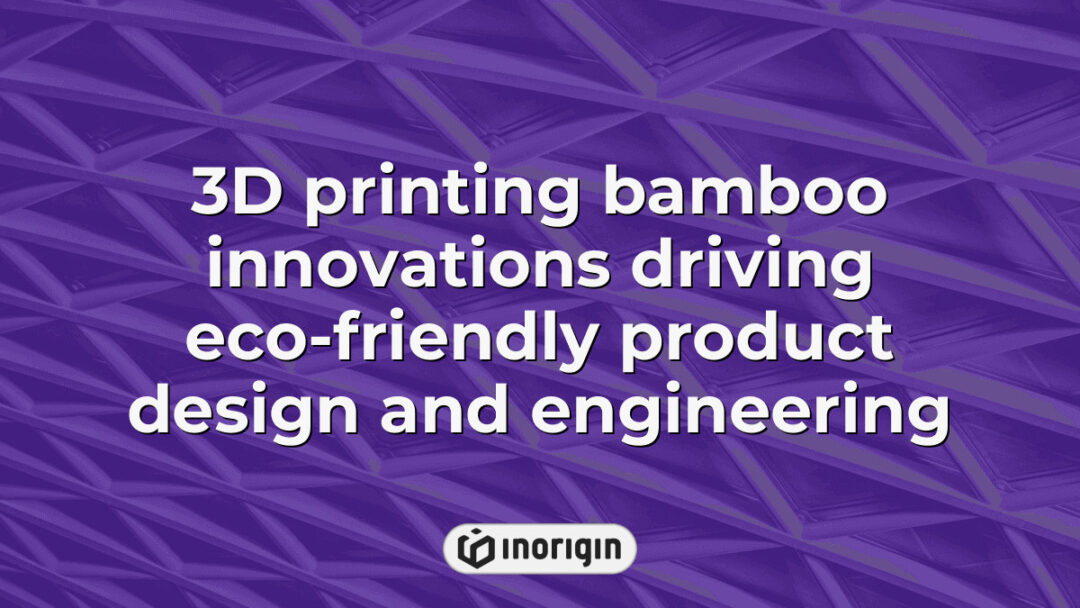In a world increasingly defined by its ecological challenges, the tale of bamboo offers both inspiration and innovation; renowned for its rapid growth and resilience—one species can reach towering heights of over 30 meters in just a few months—bamboo emerges as a versatile resource that intersects with cutting-edge technology. As industries seek sustainable alternatives to traditional plastics and foams, the application of 3D printing technologies to this remarkable plant opens new avenues for eco-friendly manufacturing processes. By harnessing bamboo’s natural properties through additive manufacturing techniques, researchers and designers are not only redefining material possibilities but also addressing significant environmental concerns linked to waste and sustainability. This article delves into the transformative potential of 3D printing bamboo, exploring its unique attributes, applications, and implications for future production systems while paving the way toward greener innovations.
| Aspect | Key Takeaway |
|---|---|
| Sustainability | 3D printing bamboo leverages bamboo’s rapid growth and renewability, offering an eco-friendly alternative that aligns with sustainable manufacturing goals. |
| Material Properties | Bamboo filaments combine natural strength with biodegradability, delivering performance comparable to conventional plastics while reducing environmental impact. |
| 3D Printing Process | Optimizing filament preparation, printer settings, and post-processing is essential for achieving high-quality 3D prints using bamboo composites. |
| Applications | Bamboo 3D printing serves a variety of uses, including eco-conscious prototyping, sustainable furniture, and lightweight structural components. |
| Challenges | Addressing bamboo filament’s moisture sensitivity and brittleness is crucial to ensure print precision and mechanical reliability. |
| Health and Safety | Implementing ventilation and protective equipment is important to mitigate respiratory risks associated with bamboo dust during printing. |
| Future Trends | Ongoing innovations in 3D printing tech and bamboo composite formulations are expanding applications while enhancing material properties. |
Exploring The Materials: Bamboo Filament And Composites
The exploration of materials utilized in additive manufacturing reveals the significant role of bamboo filament and its composites within the 3D printing landscape. Bamboo, known for its rapid growth and sustainability, serves as an advantageous source material when converted into filament suitable for various printing applications. Within this context, Bambu Lab has emerged as a notable contributor to the development and optimization of bamboo-based filaments, enhancing their mechanical properties and printability characteristics. Furthermore, studies indicate that these filaments exhibit comparable performance metrics to traditional plastics while simultaneously offering environmental benefits due to their biodegradable nature. Transitioning from pure bamboo filament, composite formulations incorporating bamboo fibers with polymers have been investigated; such innovations not only improve tensile strength but also expand the range of potential applications in both industrial and consumer realms. As research continues to evolve, a deeper understanding of the synergistic effects between bamboo-derived materials and additive manufacturing processes will pave the way for more sustainable practices within the field of 3D printing.
The Process: How To 3D Print With Bamboo
The notion of transforming a humble plant, often associated with pandas and serene bamboo groves, into intricate three-dimensional objects through digital fabrication tactics evokes an intriguing paradox. The process of 3D printing with bamboo involves several critical steps that can bridge the gap between nature and technology seamlessly. First, it is essential to prepare the appropriate filament; bamboo composites, typically combined with polylactic acid (PLA), ensure compatibility within conventional Fused Deposition Modeling (FDM) printers like the Bamboo Lab X et al., which excel at controlling extrusion temperatures and preserving material integrity. Next, precise settings must be configured on the D printer for optimal layer adhesion and print quality, considering variables such as nozzle temperature, build plate temperature, and speed. Finally, post-processing techniques significantly enhance surface finish and structural performance; methods may include sanding or applying protective coatings to achieve a refined appearance while extending durability.
Moreover, when engaging in this innovative endeavor of creating eco-friendly artifacts from agricultural byproducts such as bamboo filament, attention must also be given to environmental considerations surrounding waste management during production cycles. As the popularity of sustainable practices rises within the manufacturing sector, integrating biocompatible materials imparts unique attributes—both aesthetically pleasing visuals reminiscent of organic textures alongside reduced ecological footprints traditionally linked to petroleum-based plastics. Thus, while engaging in 3D printing with bamboo may initially appear whimsical or unconventional, it ultimately exemplifies a convergence of artistry and functionality underpinned by technological advancement in today’s dynamic landscape of digital fabrication.
Applications Of Bamboo In 3D Printing
The applications of bamboo in 3D printing are diverse and noteworthy, particularly as advancements in desktop 3D printers allow for increased precision. Firstly, bamboo filament, composed of a blend of finely ground bamboo fibers and biodegradable polymers, can be utilized to produce environmentally friendly prototypes and final products. This material not only possesses aesthetic qualities but also provides structural strength desirable in various fields such as architecture and product design. Furthermore, the incorporation of bamboo into additive manufacturing facilitates innovative furniture designs that emphasize sustainability while maintaining functionality. Secondly, due to the inherent properties of bamboo, including its lightweight nature and flexibility, this material is ideally suited for creating components used in the aerospace and automotive industries where performance optimization is critical. Thus, the application spectrum extends beyond mere aesthetics to practical use cases requiring high-performance materials.
By embracing bamboo as an integral part of 3D printing processes, designers can contribute significantly towards reducing ecological footprints associated with traditional manufacturing methods. The allure of utilizing renewable resources like bamboo fosters creativity while promoting sustainable practices within innovative sectors ranging from art installations to functional household items. Integrating bamboo into projects offers a unique opportunity to align technological advancement with environmental stewardship—making every print not just a model or prototype but also a promise toward a more responsible future.
Challenges And Considerations In Bamboo 3D Printing
The integration of bamboo into 3D printing presents both innovative opportunities and significant challenges that must be navigated for successful implementation. Initially, envisioning a scenario akin to early mechanized inventions—such as the steam engine—highlights the transformative potential of this technology; however, achieving seamless operation with bamboo filaments requires thorough understanding and adaptation. Specifically, while modern CoreXY 3D printers offer enhanced speed and precision through their distinct motion system, they also demand careful calibration when handling biomass materials like bamboo composites. Consequently, users may encounter a steep learning curve associated with material properties such as moisture absorption and brittleness, which significantly differ from typical thermoplastics used in conventional 3D printing practices. Furthermore, considerations regarding print settings—including temperature, extrusion rates, and bed adhesion techniques—are crucial factors that can influence print quality and mechanical performance. Thus, despite its promising applications, mastering the complexities of bamboo filament processing within 3D printers necessitates an informed approach to overcome operational hurdles effectively.
Future Innovations And Trends In Bamboo 3D Printing
The landscape of bamboo 3D printing is poised for significant advancements, driven by emerging technologies and innovative methodologies. Recent developments in 3D printers capable of utilizing bio-based materials have opened new avenues for integrating bamboo filament into various applications, enhancing the sustainability aspect of additive manufacturing. Moreover, initiatives like Bamboo Lab X exemplify collaborative efforts aimed at optimizing the performance characteristics of bamboo composites while ensuring ease of processing. Transitioning from traditional approaches to more sophisticated techniques will likely facilitate multi-color material use in producing intricate designs that showcase the aesthetic versatility of bamboo. Additionally, ongoing research surrounding eco-friendly additives promises further improvements in mechanical properties, positioning bamboo as a competitive alternative to conventional plastics in multiple sectors. As these trends unfold, it becomes evident that the future of bamboo 3D printing holds immense potential for both environmental benefits and enhanced creative possibilities.
Frequently Asked Questions
What Are The Environmental Benefits Of Using Bamboo For 3D Printing?
The notion of sustainability often conjures images of cutting-edge technologies in stark contrast to the natural world, yet the advent of 3D printing technology utilizing bamboo illustrates a harmonious relationship between innovation and ecological stewardship. First, bamboo serves as a highly renewable resource; it exhibits rapid growth rates, reaching maturity within three to five years compared to traditional timber species that can take decades. Furthermore, when cultivated responsibly, bamboo requires minimal pesticides and fertilizers, thus mitigating adverse environmental impacts typically associated with conventional agricultural practices. Additionally, the carbon sequestration potential of bamboo is noteworthy; this grass species absorbs significant amounts of carbon dioxide during its growth cycle, thereby contributing positively to efforts aimed at combating climate change. Transitioning toward bamboo-based materials for 3D printing not only reduces reliance on fossil fuel-derived plastics but also promotes biodegradability—an increasingly vital characteristic amidst rising concerns regarding plastic pollution in ecosystems worldwide. As more researchers and manufacturers embrace bamboo filament for additive manufacturing processes, the cumulative effects could lead to greener production methods and foster an increased awareness about sustainable material choices in contemporary design paradigms.
How Does Bamboo Filament Compare To Traditional Plastics In Terms Of Durability?
The comparison of bamboo filament to traditional plastics regarding durability reveals notable differences that merit consideration. Firstly, bamboo filament is derived from a renewable resource, which influences its physical properties when subjected to 3D printing processes. Research indicates that while bamboo filaments can exhibit adequate strength for many applications, they generally do not match the tensile strength and impact resistance found in conventional materials such as ABS or PLA. Consequently, products manufactured using bamboo filament may be more susceptible to deformation under stress or exposure to elevated temperatures compared to their plastic counterparts. Furthermore, the moisture absorption characteristics of bamboo composites can lead to dimensional instability over time; thus, it is essential for users to consider environmental conditions during the design phase. Despite these limitations, advancements in material processing techniques and composite formulations are underway, aiming to enhance the mechanical performance of bamboo-based filaments. Such developments suggest that while traditional plastics may currently hold advantages in terms of durability, ongoing research into bio-composite technology has the potential to improve the application scope of bamboo filaments in various industrial domains.
Can Bamboo 3D Printing Contribute To Sustainable Architecture?
The allure of sustainable architecture lies in its potential to harmonize human habitats with the natural environment, evoking a vision where structures are both functional and symbiotic with their surroundings. Bamboo 3D printing emerges as a promising avenue for achieving this ideal. As an abundant and rapidly renewable resource, bamboo offers not only mechanical strength but also an environmentally friendly alternative to conventional building materials that have been criticized for their high carbon footprints. Transitioning from traditional construction methods to those utilizing bamboo filament can significantly reduce reliance on non-renewable resources while minimizing waste generation during manufacturing processes. Moreover, the unique properties of bamboo contribute aesthetically pleasing designs that resonate with biophilic principles, fostering well-being among occupants.
Furthermore, the incorporation of bamboo-based additives in 3D printing technology enables architects and designers to create complex geometries that enhance structural efficiency while simultaneously addressing ecological concerns. The lightweight nature of bamboo alleviates material transportation impacts, presenting opportunities for localized sourcing and production practices within communities. This shift towards integrating organic materials into architectural design symbolizes an evolving philosophy in which sustainability informs innovation rather than constraining it. In terms of energy consumption, the cultivation and processing of bamboo generally require lower input levels compared to other timber or synthetic counterparts, further solidifying its role as a cornerstone for future eco-conscious developments. By embracing bamboo 3D printing techniques within architecture, it is feasible to forge pathways toward resilient built environments that celebrate ecological stewardship and inspire ongoing comprehensive re-evaluation of how constructions can be designed sustainably.
Are There Health Concerns Related To The Dust Created From 3D Printing With Bamboo?
The dust generated from 3D printing with bamboo can present health concerns that warrant careful consideration. Much like the fine particles released during traditional woodworking processes, bamboo 3D printing produces particulate matter that may become airborne and inhaled by operators and nearby individuals. Research indicates that exposure to wood dust is associated with various respiratory issues, irritation of mucous membranes, and allergic reactions. The specific characteristics of bamboo dust, including its composition and particle size, contribute significantly to these potential health risks; thus, it is imperative for users engaged in this manufacturing process to implement effective safety measures. For instance, utilizing proper ventilation systems or wearing protective respiratory equipment can mitigate exposure and safeguard against adverse effects on health. Furthermore, regulatory guidelines regarding occupational exposure limits should be adhered to in order to ensure a safe working environment when employing bamboo as a feedstock in additive manufacturing technologies. Taking these precautions not only protects individuals but also underscores the importance of prioritizing health considerations within the evolving domain of sustainable design practices incorporating biodegradable materials such as bamboo.
How Does The Cost Of Bamboo Filament Compare To Other 3D Printing Materials?
The cost of bamboo filament in the landscape of 3D printing materials can be likened to a rare, sustainable oasis amidst a desert of conventional plastics. Analyzing the price point reveals that while bamboo filament tends to range from $20 to $30 per kilogram, it is often perceived as a more economical option compared to specialty filaments such as nylon or carbon fiber, which may exceed $50 per kilogram. Furthermore, when juxtaposed with standard PLA or ABS materials—typically available for approximately $15 to $25 per kilogram—the financial implications for consumers and businesses are noteworthy; however, one must consider additional factors such as print quality and material characteristics alongside mere cost. As demand for eco-friendly alternatives continues to rise, market dynamics indicate that prices could further evolve, affecting both accessibility and adoption rates among various user demographics within the 3D printing community. Therefore, understanding these economic variables becomes crucial for stakeholders seeking to make informed decisions regarding material utilization in their projects.
Conclusion
The integration of bamboo in 3D printing stands as a testament to innovation, where sustainability meets technology. As challenges are addressed and advancements emerge, the potential for creating eco-friendly products blossoms, promising a greener future. Ultimately, bamboo’s role in additive manufacturing will flourish, reshaping perceptions of sustainable materials.
Related posts:
- Innovations Transforming Sustainable Manufacturing with Bamboo 3D Printing
- Sustainable Innovations and Material Performance in 3D Printer Bamboo Filament
- Bamboo 3D Printer Revolutionizing Sustainable Product Design and Engineering at Inorigin
- Sustainable Innovation and Performance of the Bambu Printer in Modern 3D Printing
- Precision Engineering and Advanced Features in the Bamboo Labs 3D Printer for Professional Prototyping
- Precision Engineering and Advanced Features of the Bamboo Lab 3D Printer for Product Development




